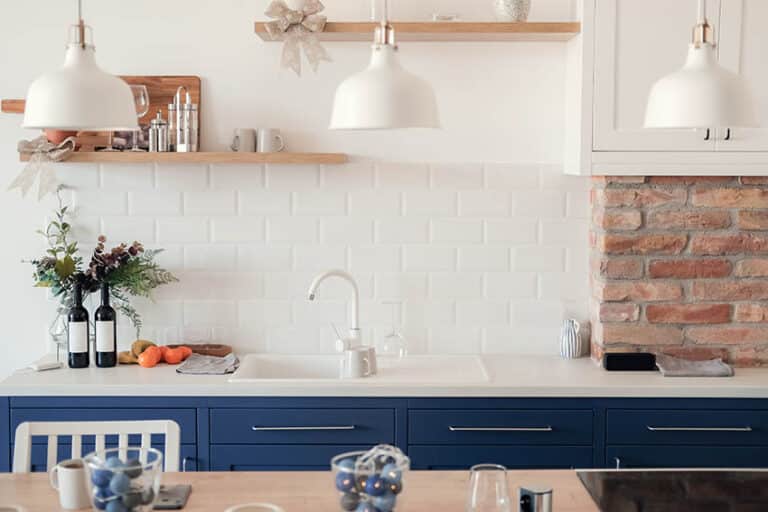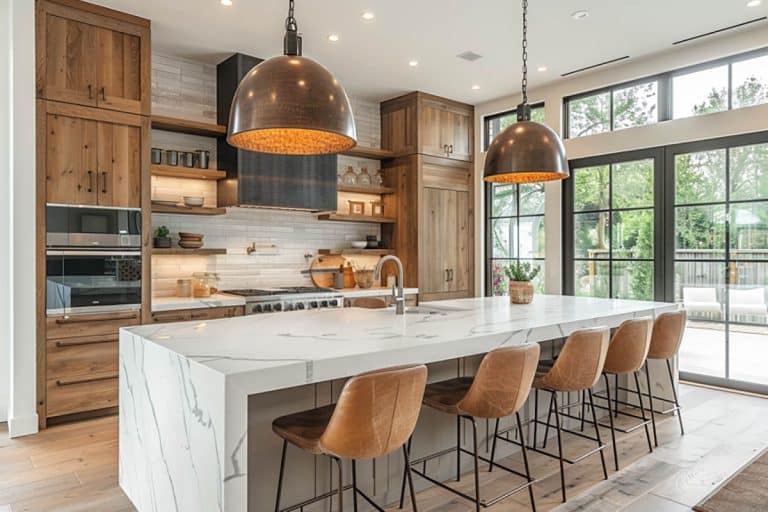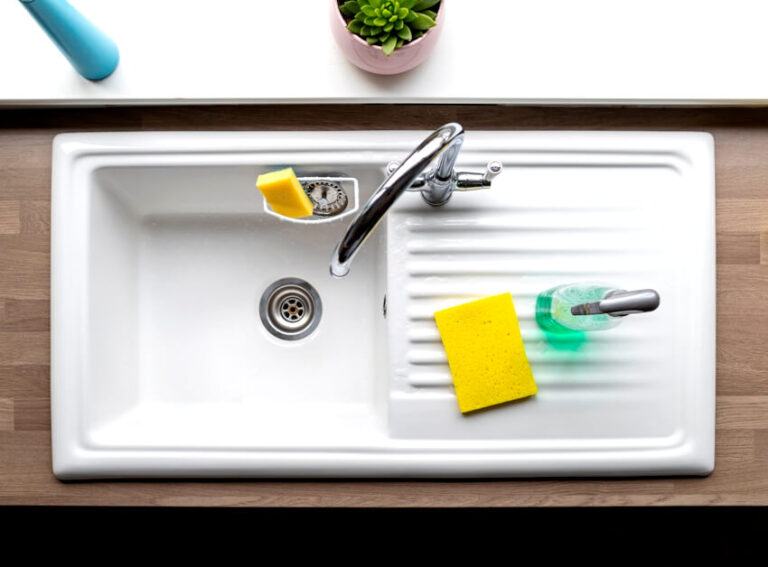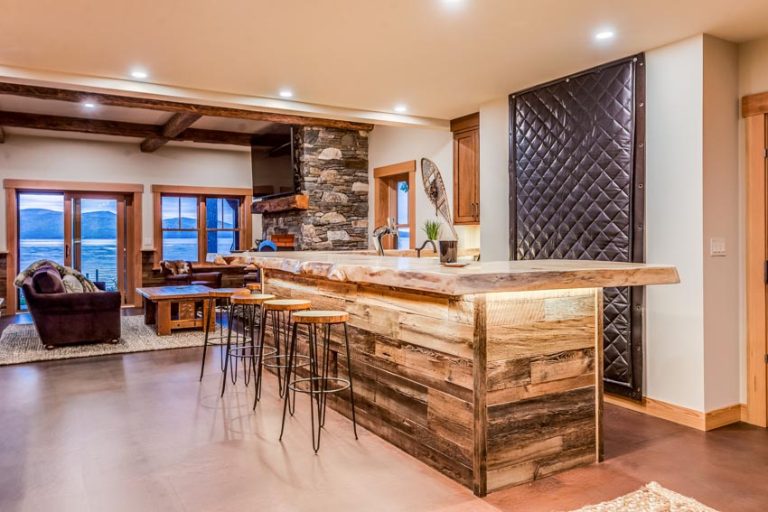Are Tile Countertops Right for Your Home? Weighing the Pros and Cons

Tiles are considered a classic at home, whether they are installed for your flooring or your countertops. They started to be used and became popular in the 70s and 80s but can still be found today, often as a remnant of the past but even occasionally as installs for new houses.
But why are tiles still popular to this day and why is it a major consideration for counter? It is a basic material used and many people prefer it because it’s affordable and versatile. With the emergence of natural stone worktops, though, there are some that are still fond of using them.
This is especially true when considering how rustic they appear and how durable they are. But tile countertops can also be fashionable because of the different types available and the designs and creative patterns that can be created and arranged using tiles.
Types Of Tile Countertops
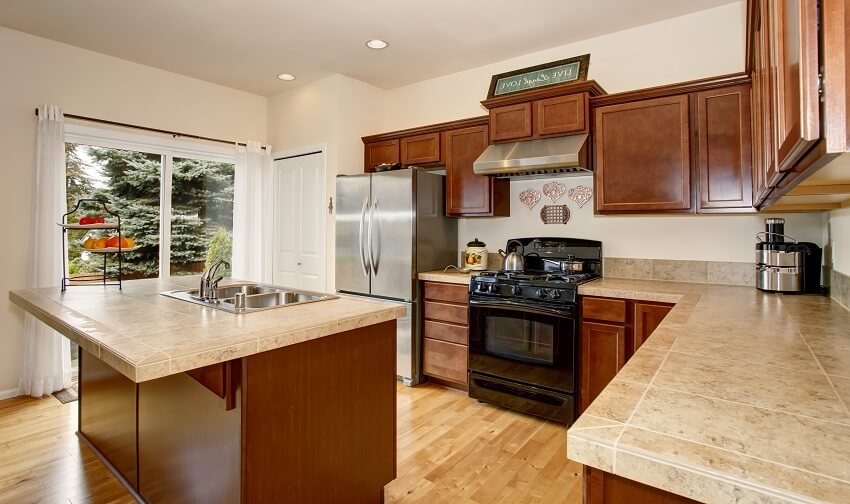
Tile countertops come in a variety of forms, colors, and designs. There is a bit of a competition between porcelain and natural stone when it comes to kitchen countertops.
While natural stone is a good option since the material doesn’t show imperfections but sealing is required regularly, which is the opposite for porcelain tiles. While this material doesn’t require sealing the trade-off is it will have grout that needs frequent cleaning.
Some of the types based on material include the following:
• Ceramic
• Glass
• Marble
• Granite
Besides different materials, tiles also have different shapes available as your options. There are standard squares and quirky octagons.
And if you want an even quirkier and rarer shape, you would have to create the shapes yourself. This is a possible task to accomplish since tiles can be cut to create the shape you desire. See our gallery of tile shapes here.
Pros Of Tile

In being sure if tile countertops are the best option for your home, it is a must to weigh the advantages and disadvantages that you will encounter.
While there are a lot of considerations to be taken in order to know the accurate benefits to enjoy and hassles to be aware of, you can check out different factors and elements in a general fashion.
Here are a few pros to expect:
• Variety & endless creative possibilities – With a variety of types, colors, shapes, sizes, and designs to choose from, there are endless possibilities when it comes to how you create your counters. You can even check out different textures available, from crackled and smooth glazed to handpainted and matte. Your creativity and imagination are the only elements that could limit you (And your budget too!).
• Easier to fix and replace – These counters are easier to fix and replace, primarily because you can easily remove the damaged piece and replace it with a new one.
• More affordable in cost – Tiles are cheaper when compared to natural stone but they can still be considered costly depending on your budget. The installation cost, if you’ve not chosen to DIY it, also needs to be considered and would depend on your home’s area.
• Heat-resistant – While tiles are heat-resistant, it is still advisable to use something to put a hot pot on when you place it on the countertop.
Cons of Tile
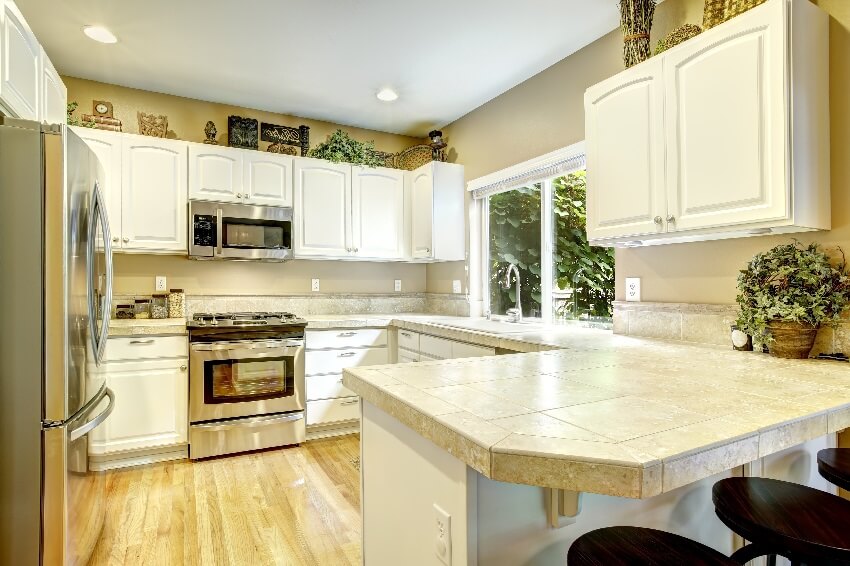
More than the different benefits that you can enjoy, there are also several disadvantages you will face with this type of countertops. Here are some of the hassles that you will have to face.
• Susceptible to bacteria and stains – They have a porous surface and so use grout to put the tile in place. And grout has the tendency to absorb liquid, leading to staining which can result in the growth of bacteria in the end. This is particularly important in counters where a lot of food preparation and handling are done.
• Tough to clean – With liquid and stains absorbed over time, cleaning grout and porous ceramic tile can be hard labor to accomplish. To help you with this cleaning chore, you can use the following solutions and combinations with a stiff-bristled brush:
-
- Baking soda paste and vinegar
- Vinegar and warm water
- Hydrogen peroxide
- Oxygen bleach
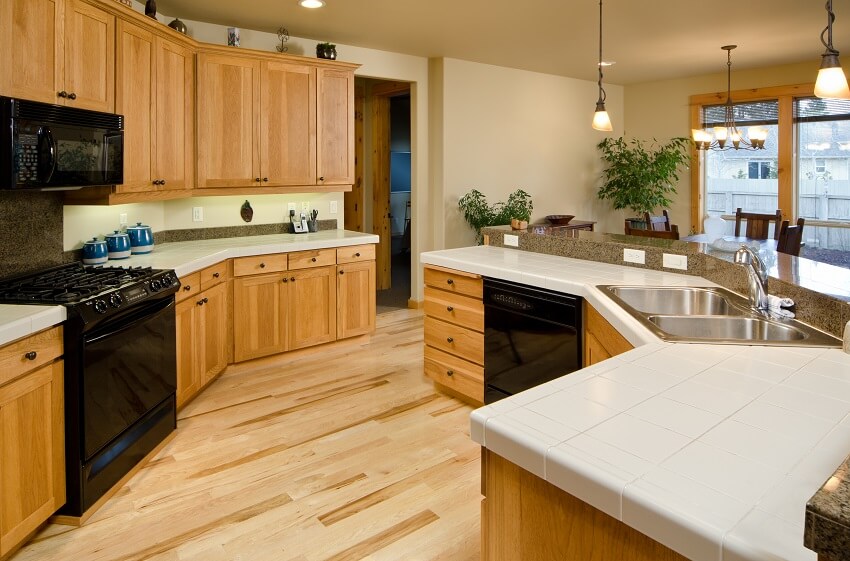
• Certain tile requires frequent sealing – Since these counters are susceptible to staining and bacteria growth, sealing is necessary for protection. Some types need annual sealing but others may require more frequent than that.
• Easily chips and may not be the most durable – Tiles may be known for being heat-resistant but they are also popular for not being durable and can easily be chipped. One little bang or a can damage the tile and so won’t be used anymore. Ceramic tiles are particularly softer and can easily be damaged when not careful.
While these disadvantages may clearly be a hassle, there are ways you can prevent them. You can protect these counters from bacteria and stains through sealing and being careful when handling the tiles or choosing a more durable material for these countertops can ease the chipping problems you may encounter.
Cost
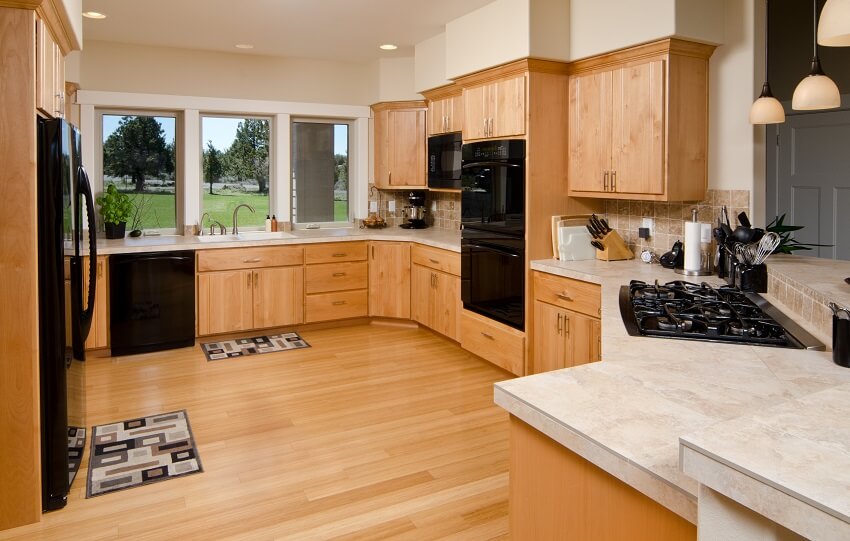
Cost is a big consideration in building and renovation projects like when dealing with tile countertops. While they are considered more affordable compared to other options you have, they can still rip part of your budget out. This is the reason why it is still important to plan your budget despite how affordable you think it may be.
When considering a 30-square foot of ceramic counters, the cost can fall between $1,000 and $2,000. Two factors that can affect the cost are installation and materials.
Choosing glass tiles is more expensive than other types. More than that though, the installation cost may increase if you choose hand-painted tiles since there is certain care needed for its installation.
When considering the materials, the cost ranges from $1 to $15 per square foot. And depending on the type of tiles, it can be on the lower part of that range or higher part of that range. Here are some of the costs of the materials for these types of tiles:
| Type of Tiles | Cost of Tiles |
| Ceramic & porcelain | $2 to $3 per square foot |
| Stone (Granite, slate, or marble) | $4 to $7 per square foot |
| Glass | Up to $30 per square foot |
Glass tiles are specifically costly because they are made by glass artisans and require a multistep process and handcrafting.
Besides different costs in terms of materials, the installation plays an important role in the cost. If you know how to DIY and install these counters, this can help you save a lot of money.
If you don’t have the knowledge and skills to install the counters yourself, here are the installation costs you can expect based on the type of tiles you choose.
| Type of Tiles | Installation Costs |
| Ceramic | $18 to $35 per square foot |
| Natural stone | $45 to $75 per square foot |
| Glass | Up to $100 per square foot |
| Porcelain | $3 to $35 per square foot |
Ceramic tiles are popular to be cheaper, in materials and installation alike. Installation costs can increase once it requires more attention and additional skills.
Compared to slab countertops though, installation of tiles is still way more affordable. Slab counters can range from $75 to $200, including granite, engineered quartz, soapstone, and concrete.
Is Tile Outdated?
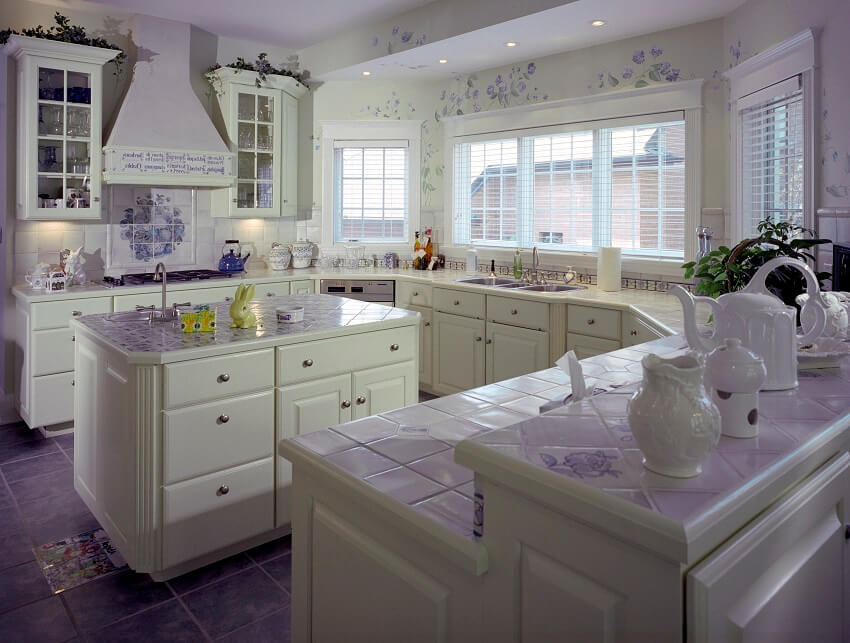
Tile countertops became a huge hit in the ‘70s and ‘80s but does this mean that they are already outdated? When it comes to designs and styles, everything just comes around even after its popularity. Certain types of porcelain tile countertops can be resistant against stain, water, scratch, heat, and dent, which makes them a very good option.
These tile counters are flexible when it comes to shapes, patterns, and designs. Despite being a trend that started in the ‘70s, it can look surprisingly modern. Your imagination and creativity are the only factors that can limit your design for your counters (besides your budget if you’re a bit on the thrifty side). See some examples of tile patterns here.
But when it comes to the fact that tile countertops are outdated or not, the straight answer is, for most people, yes. Although, the flexibility of tiles helps in making them last all the way to today from their popularity in the ‘70s.
Can You Put Hot Pans On Tile?
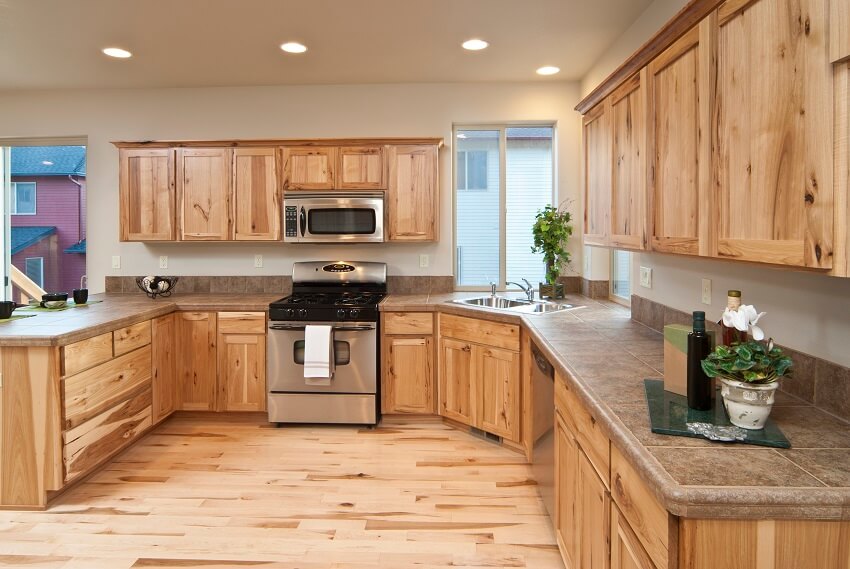
Tile countertops are known to be heat-resistant but this does not mean that you can be careless when handling the heat. Can you put hot pans on tile?
Yes you can, and you can do so without the fear of instantly damaging your counters. This even means you can set up your counters next to the oven or stove.
Ceramic and porcelain, which are two types of tiles you can choose, have a high thermal conductivity level and can take up to 84 degrees Farenheit.
While they may be heat-resistant, they are not heat-proof, which means that repeated and too much exposure can damage the tiles in the end.
You should be extra careful when dealing with their grouts since compared to the tiles themselves, the grouts are porous and prone to chipping.
Are Tile Surfaces Sanitary?
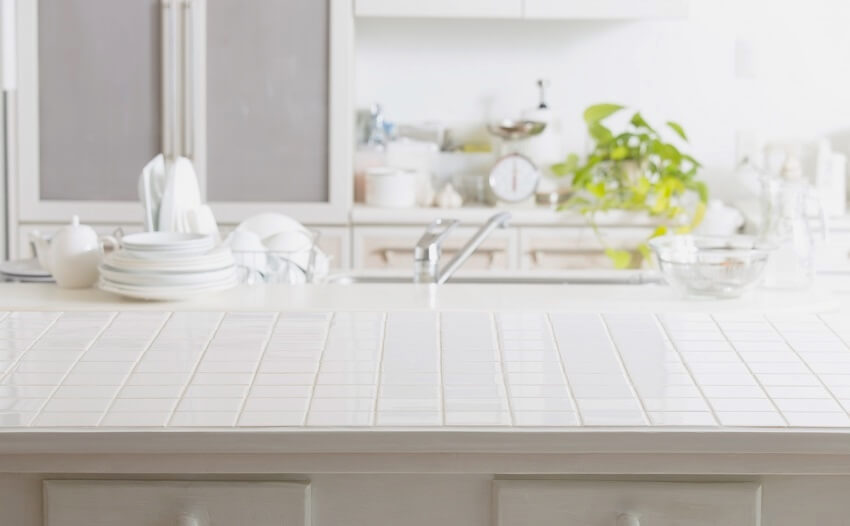
Tile countertops are known to be susceptible to stains and accumulation of bacteria because of their grout lines. Grouts are used to make sure that the tiles stick and remain in place. But they are porous and so can be stained and difficult to clean.
The accumulation of bacteria, dirt, germs, and moisture can make the counters totally unsanitary. This can be a big disadvantage, especially since food management and preparation are conducted on the countertops.
Proper cleaning is necessary to maintain the sanitary of these counters. Here are some tips you can follow to ensure this:
• Use appropriate cleaning solution and methods fitting to the tile type and its grout.
• Avoid things that can compromise the cleanliness and quality of your counters.
• Wide down the surface after every after use.
• Give special attention to your tile countertop’s grout to avoid possible accumulation of stain and bacteria.
• Learn how to do deep cleaning on your counters (Choose a strong tile cleaning solution that can sanitize both the grout and the tile’s surface but not too harsh that its surface can be damaged because of it. The best option is to use gentle cleaner on the surface and an extreme one on the grout.
Are Tiles Good For Countertops?

When considering whether tiles are good for counters or not, it is best to consider the different characteristics that tiles boast. And matching them with your needs and what you need for your countertops will follow.
There are two types of tiles considered the most popular in terms of counters, including ceramic and porcelain. Tiles are an affordable option and ceramic is particularly the cheapest choice you can checkout.
Ceramic counters are known to be stain, water and, heat-resistant when properly glazed, which is the reason why it is an excellent material for counters The same can be said about porcelain tile countertops but only more tolerant for higher temperatures and more expensive than its ceramic version.
Kitchen countertops serve as the headquarters for meal preparation and management in the room. Countertops need to be clean and sanitary with all the food preparation you do on it. And the surface of tile countertops is resistant from stain and bacteria, making it a good choice for the kitchen.
Its grout can be vulnerable to them though and can in fact accumulate germs and dirt in the process. This is why deep cleaning is absolutely important and sealing frequently is necessary to protect the tiles.
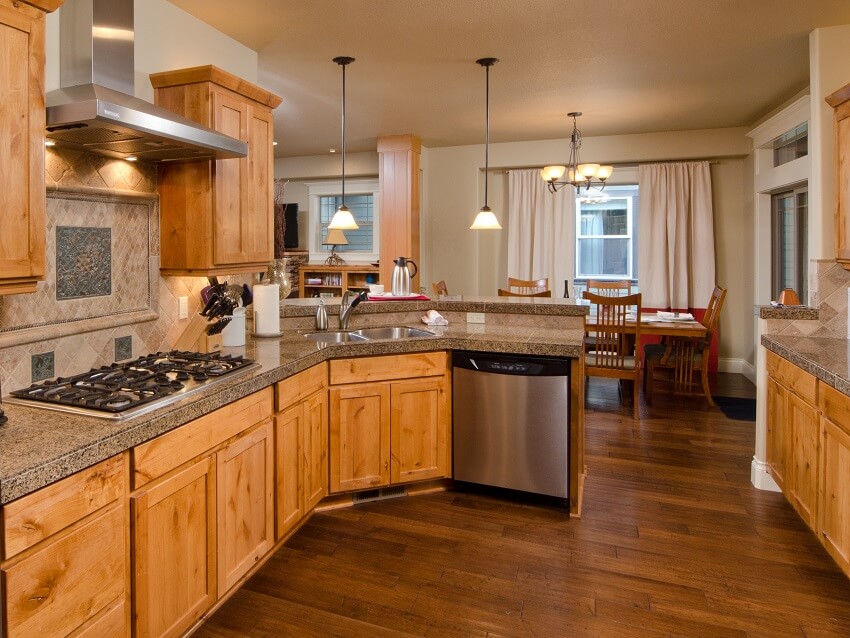
Another factor that makes tile countertops excellent is that they are heat-resistant. There is a high chance that you will be handling hot food and would be placing them on top of the countertops.
With the characteristics of tile countertops being resistant to heat with high thermal conductivity level, tile countertops, specifically ceramic and porcelain tile countertops can be incredible.
Ceramic and porcelain tile countertops can take a maximum of 84 degrees Farenheit. You can put hot pans and plates on top of the tile countertops worry-free since you don’t have to be concerned about the possible staining and chipping.
Visit our guide to painting kitchen tile countertops for more related content.


